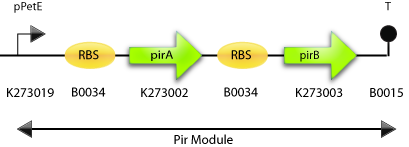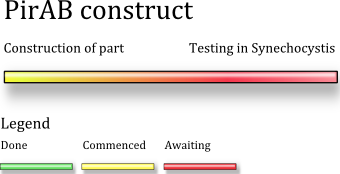Team:Uppsala-Sweden/pir
From 2009.igem.org

Contents |
The Theory
The protein Pirin has in Serratia marcescens been shown to regulate the pyruvate levels by means of inhibition of the PDC [1]. While the Pirin superfamily is diverse and has different functions across different organisms it has been linked to growth inhibition in Synechocystis sp. PCC 6803 [2]. One could assume that this is done in the same way as in S. marcescens, by inhibiting the PDC and thus choking the Krebs cycle. In S. marcescens this leads to induction of fermentation pathways.
As a side effect we have found data on the ethanol resilience of Synechocysti, obtained through a test of induction of Pirin by ethanol stress [2], it is here shown that ethanol up to 5% in the growth media has a positive growth effect while it is detrimental to growth at 7.5%. Inhibited growth may be acceptable to us as we would typically be at optimum population density during ethanol production in either case. This proposes that Synechocystis sp. PCC 6803 could potentially tolerate concentrations higher than 7.5%.
The Constructs
and : The desired Construct for Testing Purposes

Status
as of 2009-10-21
The pirAB construct is not yet completed due to some cloning misfortunes with the pirA part. Being short on time and manpower we decided to focus on other parts of the project. Primarily the anti sense RNA:s that are being developed for the same purpose as the pirAB construct, namely shutting down the PDC.
References
[1] [http://jb.asm.org/cgi/content/abstract/189/1/109 Pirin Regulates Pyruvate Catabolism by Interacting with the Pyruvate Dehydrogenase E1 Subunit and Modulating Pyruvate Dehydrogenase Activity. Po-Chi Soo,1, Yu-Tze Horng,1, Meng-Jiun Lai,3 Jun-Rong Wei,1 Shang-Chen Hsieh,1 Yung-Lin Chang,1 Yu-Huan Tsai,1 and Hsin-Chih Lai1,2Journal of Bacteriology, January 2007, p. 109-118, Vol. 189, No. 1]
[1] [http://www.sciencedirect.com/science?_ob=ArticleURL&_udi=B6T36-4D3WD29-3&_user=651519&_rdoc=1&_fmt=&_orig=search&_sort=d&_docanchor=&view=c&_searchStrId=1056035794&_rerunOrigin=google&_acct=C000035158&_version=1&_urlVersion=0&_userid=651519&md5=45a316c9d6afe02fa2bd6570d6a7c902 A cyanobacterial gene encoding an ortholog of Pirin is induced under stress conditions. Yukako Hiharaa, Masayuki Muramatsua, Kinu Nakamuraa and Kintake Sonoikeb, FEBS Letters 574 (2004) 101–105]
 "
"




